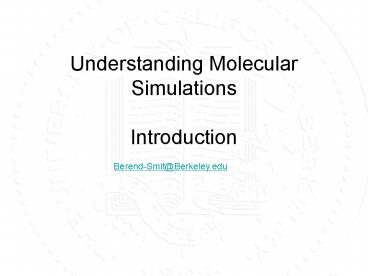Understanding Molecular Simulations Introduction - PowerPoint PPT Presentation
1 / 17
Title:
Understanding Molecular Simulations Introduction
Description:
Understanding Molecular Simulations Introduction Berend-Smit_at_Berkeley.edu Why Molecular Simulations Paul Dirac, after completing his formalism of quantum mechanics ... – PowerPoint PPT presentation
Number of Views:190
Avg rating:3.0/5.0
Title: Understanding Molecular Simulations Introduction
1
Understanding Molecular SimulationsIntroduction
Berend-Smit_at_Berkeley.edu
2
Why Molecular Simulations
- Paul Dirac, after completing his formalism of
- quantum mechanics The rest is chemistry.
- This is a heavy burden the shoulders of
chemistry - The rest
- amounts to the quantitative description of the
world around us and the prediction of all
every-day phenomena ranging from the chemical
reactions of small molecules to the integrated
description of living organisms.
3
Uses of Molecular Simulations
Exact in the limit of infinitely long
simulations the error bars can be made infinitely
small
If one could envision an experimental system of
these N particles that interact with the
potential.
- The idea for a given intermolecular potential
exactly compute the thermodynamic and transport
properties of the system
Pressure Heat capacity Heat of adsorption Structur
e .
We assume the interactions between the particles
are known!
Diffusion coefficient Viscosity
4
Intermolecular potential
- The intermolecular potential can
- Mimic the experimental system as accurate as
possible - Replace experiments (dangerous, impossible to
measure, expensive, ) - Make a model system
- Test theories that can not directly be tested
with experiment
5
Example 1Mimic the real world
- Critical properties of long chain hydrocarbons
To predict the thermodynamic properties (boiling
points) of the hydrocarbon mixtures it is
convenient (Engineering models use them)to know
the critical points of the hydrocarbons.
6
Critical points of long chain hydrocarbons
Heptadecane
Pentane
7
Hydrocarbons intermolecular potential
- United-atom model
- Fixed bond length
- Bond-bending
- Torsion
- Non-bonded Lennard-Jones
CH2
CH2
CH3
CH2
CH3
8
OPLS (Jorgensen) Model
9
Vapour-liquid equilibria
But my system is extremely small, is the
statistic reliable?
Molecular dynamics press enter and see
Lectures on Free Energies and Phase Equilibrium
- Computational issues
- How to compute vapour-liquid equilibrium?
- How to deal with long chain hydrocarbons?
Lectures on advanced Monte Carlo
But C48 moves much slower than methane (C1). Do I
have enough CPU time
Molecular dynamics press enter and see
10
Critical Temperature and Density
Nature 365, 330 (1993).
11
Example 2 make a model system
My theory is RIGHT but this experimentalist
refuses to use molecules that do not have any
attractive interactions
- Question are attractive interactions needed to
form a solid phase? - YES
- Attractive forces are needed for vapour-liquid
equilibrium - Theories predict this ..
- BUT
- There no molecules with only attractive
interactions - How to test the theory?
Your theory is WRONG it disagrees with the
experiments
12
But we can simulate hard spheres ..
- Bernie Alder carried out Molecular Dynamics
simulations of the freezing of hard spheres - But, . did the scientific community accept this
computer results as experimental evidence - during a Gordon conference it was proposed to
vote on it - and it was voted against the results of Alder
13
Experiments are now possible
- .. But not on
- molecules
- but on colloids
From the following article A colloidal model
system with an interaction tunable from hard
sphere to soft and dipolar Anand Yethiraj
and Alfons van Blaaderen Nature 421, 513-517 (30
January 2003)
14
Molecular Simulations
- Molecular dynamics solve equations of motion
- Monte Carlo importance sampling
- calculate thermodynamic and transport properties
for a given intermolecular potential
rn
15
Molecular Dynamics
- Theory
- Compute the forces on the particles
- Solve the equations of motion
- Sample after some timesteps
16
Monte Carlo
What is the correct probability? Lecture
Statistical Thermodynamics
- Generate a set of configurations with the correct
probability - Compute the thermodynamic and transport
properties as averages over all configurations
How to compute these properties from a
simulation?
17
Classical and Statistical Thermodynamics
- Problem we have a set of coordinates and
velocities -what to do with it? - Statistical Thermodynamics
- The probability to find a particular
configuration - Properties are expressed in term of averages
- Free energies
- Thermodynamics relation of the free energies to
thermodynamic properties































